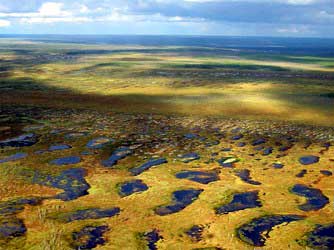Global warming appears to be causing lakes to drain and disappear in Arctic regions, a UCLA-headed team of researchers report in the latest issue of Science.
If the pattern persists, it may imperil migratory birds and wreak further havoc on the region's weather, warns Laurence Smith, the article's lead author and an associate professor of geography at UCLA.
"In the
Along with researchers from UCLA, State University of New York College of Environmental Science and Forestry in Syracuse, and the University of Alaska in Fairbanks, Smith tracked changes in more than 10,000 large lakes by comparing early satellite imagery taken across approximately 200,000 square miles of Siberian wilderness with recent satellite data.
Between 1973 and 1997–98, the total number of lakes larger than 100 acres decreased from 10,882 to 9,712, a decline of 11 percent, the team found. Most lakes did not disappear altogether, but instead shrank to sizes less than 100 acres. The total surface area in the region occupied by lakes shrank by 359 square miles, a decline of 6 percent.
In all, 125 lakes vanished completely and became covered with vegetation, the researchers found in the study, which was funded by the National Science Foundation. Subsequent monitoring has found that none of the lakes refilled, the researchers report in "
"What's interesting isn't that we're seeing individual lakes disappear," Smith said. "The process appears to be abrupt and irregular. From what we can tell from space, a lake is either just fine or it's gone."

The findings fly in the face of past climate change research, which has tended to show that Arctic warming results in the proliferation of bodies of water as moisture once bound in the icy permafrost layer melts like an ice cube, forming ponds or "ponding," in the parlance of scientists.
Indeed, the researchers found an increase in total lake area in the northern part of their study area, where the permafrost remained intact. In continuous permafrost areas, total lake area increased by 51 square miles or 12 percent and their numbers rose from 1,148 in 1983 to 1,197 by 1997–98, an increase of 6 percent.
But the trend of net lake growth in areas of continuous permafrost stands in sharp contrast with conditions in the more southerly zones of discontinuous, sporadic and isolated permafrost, all of which experienced net declines in total lake number (down by 9 percent, 5 percent and 6 percent, respectively) and area (down by 13 percent, 12 percent and 11 percent).
Overall, the declines have outpaced lake gains in the north, resulting in an overall loss to the region, the study found.
"We were totally surprised by our findings," Smith said. "We were expecting the lake area to have grown with climate change. And while it did do so in the north where the permafrost remains intact, lake area did not increase in the south, where permafrost is warming. This spatial contrast suggests that increased ponding is an initial phase as permafrost warms, followed by lake drainage and disappearance as the permafrost thaws still further.
The team blames the thawing of the permafrost layer, which otherwise serves as a water-tight membrane along lake bottoms.
"Most of these lakes are laying on top of permanently frozen ground, a surface that prevents lake water from draining into the ground, " Smith said. "We think that climate warming is thawing the permafrost. When that occurs, it's like pulling the plug out of a bathtub. There's nothing to prevent lake water from percolating through the soil to aquifers below."
Climate models suggest that temperatures will continue to climb in the Artic. "We expect areas of continuous permafrost to continue to thin and move steadily northward, resulting in the disappearance of more lakes," he said.
Arctic weather patterns have become a closely watched field in recent years because the region's climate is changing at a much faster pace than that of the rest of the globe. Arctic lakes are of particular concern because they serve as a summer habitat for many migratory birds.
"If they were to disappear, it would be disastrous for migrating birds," Smith said. "The Arctic lakes and wetlands are widely used as summertime habitat for migratory birds, and for many species they are critically important for feeding and raising their young."
Further research is required to determine if lake loss is having any effect on weather.
"We haven't measured climate changes as a result of the lakes disappearing, but we expect that the area would potentially enjoy less precipitation if the lakes continue to decline because lakes provide a source of evaporation, which creates clouds and rain in other places," he said.
The study's baseline data dates to 1972, when it was collected as part of NASA's initial Landsat mission, the first civilian satellite project powerful enough to provide clear images of the earth's surface from space. Consisting of millions of images, Landsat is the world's largest archive of satellite data outside the federal government.
"We're not used to thinking of satellite imagery as an historical document because it's still so advanced," Smith said. "But we're getting to the point where some of these data are now more than 30 years old, and they document some striking changes that have taken place over that time."
In addition to Smith, Yongwei Sheng, an assistant professor of environmental science and forestry at State University of New York; Glen MacDonald, chair of UCLA's geography department; and Larry Hinzman, research professor of water resources at the Water and Environmental Research Center at the University of Alaska, Fairbanks; participated in the research.










BEAS funding available to help businesses cut energy costs
And not a moment too soon, if the following exchange broadcast last Friday 13th June, on the Radio 4 ´Rare Earth´ program (link below, ~ 17 minutes...